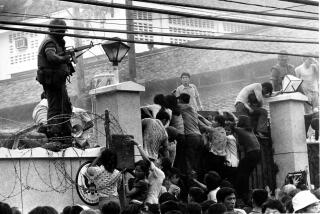A War Misconceived, but Not Pointless : Vietnam: McNamara’s <i> mea culpa</i> fails to consider the likely consequences if America had not contested the North’s aggression.
Like an underground coal fire that smolders largely unobserved but doesn’t go out, the controversies of the Vietnam War have continued to linger just below the surface of public consciousness. Now the 20th anniversary of the fall of Saigon combined with the publication of Robert McNamara’s Vietnam memoirs have reignited the old debates--and with them the old grief and anger.
McNamara’s “In Retrospect” is half mea culpa and half historical analysis. He concludes that the war was a “terrible mistake,” for which he shares heavy responsibility. An essential error, as he sees it, is that the Kennedy and Johnson administrations--wedded to the domino theory--”misjudged” and “exaggerated” the geopolitical consequences of a communist victory.
In the process, McNamara has effectively reiterated the message that the veterans who fought there and the families of those that died there have been receiving for more than two decades--that their sacrifice was for nothing. It was all a mistake; 58,000 dead in a misconceived, mismanaged and ultimately pointless conflict.
The irony is that McNamara is wrong--as is the prevailing consensus concerning the consequences of that war. Misconceived and mismanaged, yes; pointless, no.
First, let’s be clear on one thing: There were no easy answers in Vietnam. The best public-policy minds of a generation wrestled with Vietnam and none of them found a fully satisfactory answer. From the outset, all that seemed certain was that there would be real costs in letting South Vietnam fall under communist control and real costs in contesting that outcome. But what exactly those costs would be and how they would compare was not fully known, nor was it even knowable.
Today, we know that the cost of resisting communism in Vietnam was terribly high. What is also probable, but seldom acknowledged, is that the payment of those lives bought something--something important.
In the early 1960s, when the critical decisions were made that led the United States into Vietnam, Southeast Asia’s future was very much in doubt. Indonesia, the largest state in the region, was lurching toward a showdown between the world’s third-largest Communist Party and the army. In 1965 (“The Year of Living Dangerously”), a communist-inspired coup directed against the army high command very nearly succeeded and did succeed in assassinating six of the most senior officers.
Every other country in the region--Malaysia, Singapore, Thailand, the Philippines, Cambodia, Laos and South Vietnam--faced active communist insurgent and subversive movements. A communist government ruled in North Vietnam.
All these Communist parties, insurgencies and regimes were supported politically and to some extent materially by Beijing. By 1965, China was on the cusp of Mao Tse-tung’s epochal experiment in radical communism, the Great Proletarian Cultural Revolution, which included strident calls for global revolution. The Soviet Union, having been faced down during the Cuban missile crisis, was looking to recoup in part by fomenting and aiding a growing number of “wars of national liberation” in the Third World.
Contrast all this with the Southeast Asia of 1975, when the United States left Vietnam. Indonesia, under a pro-Western government, was stable and enjoying the first real economic development since independence. Malaysia, Thailand and Singapore--and even the Philippines--were achieving rapid rates of economic growth under stable, politically moderate regimes. In the years since 1975, Southeast Asia has become the Third World’s most spectacular success story.
Meanwhile, Vietnam, while militarily victorious, was economically prostrate--a condition exacerbated by its ill-fated invasion and occupation of Cambodia in 1978. For its part, Cambodia had been virtually destroyed by the ultra-radical Khmer Rouge regime that seized power in 1975--a catastrophe that far exceeded even the most extreme scenarios of the domino theorists of a decade earlier.
No one can prove cause and effect between America’s Vietnam involvement and the extraordinary transformation of Southeast Asia during the same period. But many Southeast Asians will volunteer the judgment that American forces bought the region a critical decade that was used to fend off the communist challenge and build the vibrant countries we see there today.
Consider the alternative. Had the United States stood aside, Hanoi would certainly have established control in South Vietnam by 1965 at the latest. At the same time, companion regimes would have taken power in Laos and Cambodia under the Pathet Lao and Khmer Rouge. The communist insurgency in the adjoining border areas of northeast Thailand would surely have been strengthened, putting the pro-Western military regime in Bangkok under increasing pressure.
In Singapore, would Lee Kwan Yew have won his last-ditch, winner-take-all contest for power with Singapore’s communists if communism seemed the clear wave of the future in the region? Many who were there at the time think not.
Could the tenuous political peace between Malays and Chinese in Malaysia have been maintained as Chinese-supported communist movements gathered strength on Malaysia’s doorstep? Would the Sino-Soviet split have become so acrimonious so rapidly in the late 1960s and early 1970s, had not the two communist giants been at loggerheads over how best to respond to the American military presence in Vietnam? No one can be certain, but an educated guess says that the answer to each of these questions is no.
For Americans, Vietnam will remain a bitter memory. but we owe it to those who fought and died there to give them credit for what they achieved. And we owe it to ourselves to build current policy on a more balanced and healthier understanding of our legacy in the region.
More to Read
Sign up for our Book Club newsletter
Get the latest news, events and more from the Los Angeles Times Book Club, and help us get L.A. reading and talking.
You may occasionally receive promotional content from the Los Angeles Times.






